Angels and Demons and Churches of Rome
I first visited Rome in 2003, a few months after the release of Madonna’s ‘American Life’. In ‘Nothing Fails’, the album’s third single, she’d sing ‘I’m not religious/But I feel so moved/Makes me wanna pray’. Back then, this lyric resonated with me, albeit only in part. Still a teenager, I wasn’t particularly interested in churches, so I headed to the Colosseum instead of the many churches of Rome I visited this year.
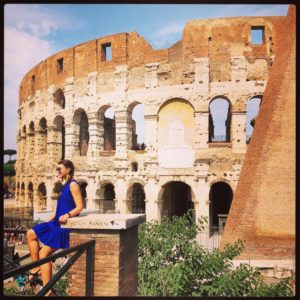
I’m still not religious, though. In the words of Madonna, ‘I’d like to express my extreme point of view/I’m not Christian and I’m not a Jew’.
During the last 19 years, however, a lot has changed. On a personal level, I qualified as a doctor and a psychiatrist, started learning Italian and moved to London. And since my first London job happened to be in Ealing, I became a regular at Santa Maria, the renowned Neapolitan pizzeria where each pizza is named after a Saint. My favourite is San Giuseppe: Fiordilatte, Smoked Mozzarella, Friarielli (Wild Broccoli), Free range rare breed North Yorkshire Pork Sausage, Parmesan. No Tomato Sauce (£14.95).
Angels and Demons and Churches of Rome
Meanwhile, I’ve also become obsessed with Dan Brown and Robert Langdon. ‘Angels and Demons’ is one of my favourite novels featuring the fictional Harvard professor of ‘symbology’. The author’s second novel, but the first to feature Langdon, follows the professor on a quest around Rome. As he tries to solve the murder of a world-class scientist and to prevent a terrorist attack, he unlocks the mysteries of the Illuminati, an obscure anti-Church brotherhood thought extinct. At the same time, Brown, with his unique story-telling, illuminates the Eternal City and takes the reader on an exciting tour around the Italian capital.
So, when I went to Rome again this year, I spent most of my mornings following in his footsteps and visiting notable churches around the city. Simply walking around the city centre, I came across dozens of churches. Overall, there are over 900, and it’s unrealistic to visit them all. To make the most of my time, I compiled a list of the most important ones (including those mentioned in ‘Angels and Demons’) as well as a proposed itinerary, which I am sharing here today.
Most of the churches of Rome are free to visit, are open for a few hours in the morning, close at around midday and then open again mid-afternoon. Of course, I combined my visits with coffee breaks and meals.
Churches of Rome: Piazza del Popolo – northern flank
Piazza del Popolo is a good starting point for a walking tour around Rome. Once upon a time, this piazza was the city’s northern gateway. On the northern flank, there’s the Porta del Popolo. Right next to it, is the Basilica di Santa Maria del Popolo. The interior of the church is well worth visiting. There are two Caravaggios, the Conversion of St Paul and the Crucifixion of St Peter, both in the Cerasi Chapel to the left of the main altar. The highlight, however, is none else but the Chigi Chapel. This is where Robert Langdon and Vittoria Vetra discovered the first assassinated cardinal, buried to the waist and dirt shoved in his mouth. The Chigi Chapel was decorated by the Italian painter and architect Raphael and features works by the Italian sculptor and architect Gian Lorenzo Bernini. Among those, are the statues of the prophets Daniel and Habbakuk.
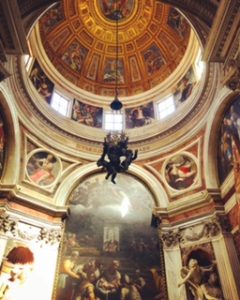
Churches of Rome: Piazza del Popolo – southern flank
Although Langdon and Vetra continued to the Vatican next, I would recommend staying at the Piazza del Popolo for a bit longer. In the centre, there’s a 36m-high obelisk brought by Augustus from Egypt. On the southern flank, opposite the Porta del Popolo, there are two identical 17th-century churches, the Chiesa di Santa Maria dei Miracoli (on the right) and the Basilica di Santa Maria in Montesanto (Chiesa degli Artisti, on the left). In between the twin churches, there’s Via del Corso leading to Piazza Venezia and the iconic Vittoriano. On the left of the Basilica di Santa Maria in Montesanto, there’s Via del Babuino, leading to Piazza di Spagna.
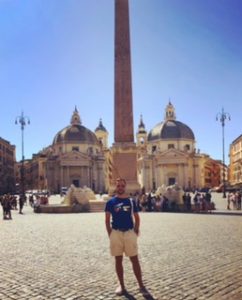
If you happen to be near Piazza del Popolo in the evening, the courtyard of the Stravinskij Bar at the Hotel de Russie (on Via del Babuino) is a beautiful place for an aperitivo, but you will need a reservation to get seated there, as well as dry weather. Sadly, my reservation got cancelled because of the rain. I went to the Enoteca Buccone (on Via di Ripetta) instead, a perfect place to taste Italian wines.
Churches of Rome: From Piazza del Popolo to Piazza di Spagna
From Piazza del Popolo, continue on Via del Babuino towards Piazza di Spagna. On your right-hand side, are the All Saints’ Anglican Church and the Chiesa di Sant’Atanasio dei Greci, a Greek Catholic titular church.
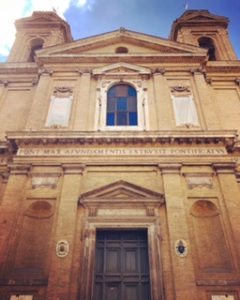
Parallel to Via del Babuino, there’s Via Magrutta, a cobbled street lined with art galleries and boutique hotels, well worth taking a small detour for.
Once you reach Piazza di Spagna, it is worth climbing up the Scallinata della Trinita dei Monti (also known as the Spanish Steps). On top of the Scallinata, there’s the Chiesa della Trinita dei Monti, as well as a panoramic view of the city ahead. Standing out is the dome of the nearby Basilica dei Santi Ambrogio e Carlo.
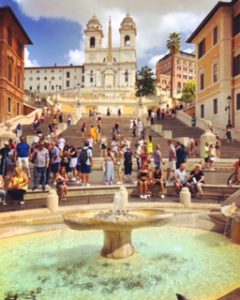
Churches of Rome: From Piazza di Spagna to Piazza di Trevi
After climbing down the 135 Spanish Steps, continue on Via dei Condotti. On your right-hand side, Antico Caffe Greco has been there since 1760. Although it’s rather expensive, it is a Rome institution and therefore well worth a pitstop. Turn right on Via del Corso (away from Piazza Venezia that is) to visit the Basilica dei Santi Ambrogio e Carlo. Then continue on Via del Corso towards Piazza Venezia.
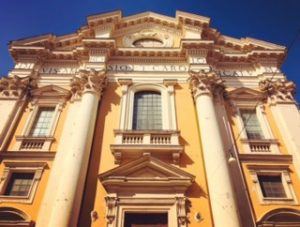
Turn left on Via delle Muratte and follow the crowds to Piazza di Trevi, where the Chiesa dei Santi Vicenzo e Anastasio overlooks the iconic Fontana di Trevi.
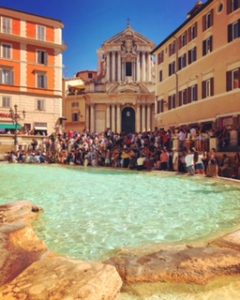
From Piazza di Trevi to Piazza di Sant’Ignazio
Once you’ve thrown a coin into the fountain, walk back towards Via del Corso. However, instead of continuing straight ahead on Via di Pietra, turn left on Via del Corso. You can then either visit the nearby Galleria Doria Pamphilj (the main entrance is on Via del Corso), or turn right on Via del Caravita (and come back to the Galleria on a different day).
The Galleria Doria Pamphilj features works by Michelangelo, Bernini, Raphael, Velasquez and many more (14 euros pp). It is located in the Palazzo of the same name (Palazzo Doria Pamphilj), not to be confused with the Palazzo Pamphilj at the nearby Piazza di Navona. Caffe Doria is a great place for coffee or brunch and can be accessed directly from Via della Gatta (parallel to Via del Corso). If it’s time for lunch or aperitivo, head to the chiostro (cloister) of the Palazzo instead.
Churches of Rome: From Piazza di Sant’Ignazio to Piazza della Minerva
From Via del Caravita, continue to Piazza di Sant’Ignazio and visit the church of the same name (Chiesa di Sant’Ignazio di Loyola). Luckily, this is one of the few churches that doesn’t close at noon. Once inside the church, look up at the fake dome brilliantly painted by Andrea Pozzo.
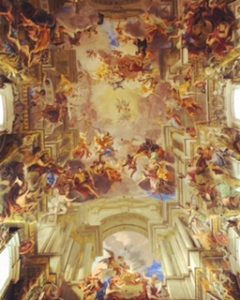
Afterwards, turn left on Via di Sant’Ignazio and visit the Basilica di Santa Maria Sopra Minerva (on your right-hand side). This is Rome’s only Gothic church and was built on the site of a temple dedicated to the Egyptian goddess Isis, but had been erroneously ascribed to the Greco-Roman goddess Minerva (hence the name of the Basilica). It is worth getting inside; look out for the Michelangelo sculpture Cristo della Minerva to the left of the altar. The Basilica can be accessed from Via di Sant’Ignazio, since the entrance is not at Piazza della Minerva, but on the opposite side.
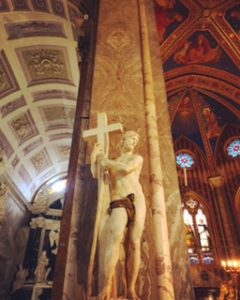
Churches of Rome: the Pantheon
Piazza della Rotonda and the Pantheon are a couple of minutes away from both Piazza di Sant’Ignazio and Piazza della Minerva.
The Pantheon was originally built by Marcus Agrippa in 27 BC. In its current form, it dates from 125 AD. Back then, it was dedicated to the classical gods (hence the name). It was much later, in the 7th century, that it was consecrated as a Christian church. As such, it is also known as the Basilica di Santa Maria ad Martyres. Inside, there are several tombs, including the tomb of Raphael, which has been there since the 17th century. Here is where Langdon and Vetra (erroneously) started their quest for the assassinated cardinals.
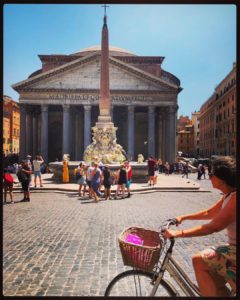
Although the Pantheon is free to enter, you need a reservation on the weekends (not on weekdays). It is best to visit around midday to see a beam of sunlight stream through the oculus (the 8.7m hole in the centre of the dome).
Churches of Rome: From Piazza della Rotonda to Piazza di San Luigi dei Francesi
Right next to the Pantheon, there’s Armando al Pantheon, a trattoria-institution (you will probably need a reservation to dine there). Stanley Tucci and I had rigatoni all’amatriciana (one of the four classic Roman pasta dishes) there. Other nearby options are Alfredo all Scrofa (the birthplace of the fettuccine Alfredo) and La Campana, the oldest restaurant in Rome. The latter is opposite the Chiesa di Sant’Ivo dei Bretoni. For gelato, there’s Giolitti, on Via degli Uffici del Vicario.
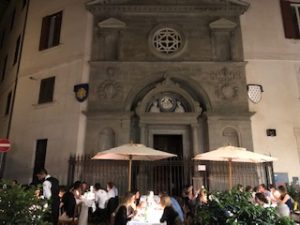
Another institution is Caffe Sant’Eustachio (no need for reservation here, but there’s only outdoor seating). Opposite the caffe, the Basilica di Sant’Eustachio was being restored at the time of my (last) visit. From the Piazza Sant’Eustachio, look out for the dome of the Chiesa di Sant’Ivo alla Sapienza, a church considered a masterpiece of Roman Baroque architecture. The entrance to the Palazzo della Sapienza and the church is on Corso del Rinascimento.
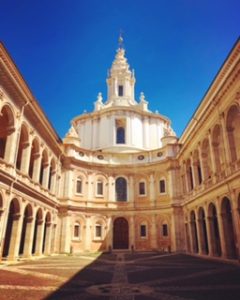
Continue on Via della Dogana Vecchia to the nearby Piazza di San Luigi dei Francesi and visit the church of the same name (Chiesa di San Luigi dei Francesi), home to three Caravaggios: the Vocazione di San Matteo, San Matteo e l’angelo, and the Martirio di San Matteo. They’re all located in the Cappella di San Matteo, to the left of the main altar.
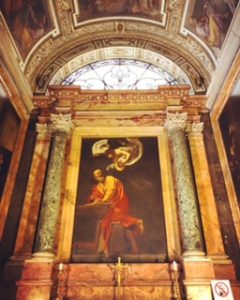
Churches of Rome: From Piazza di San Luigi dei Francesi to Piazza Navona
From there, continue to Piazza Navona, no more than a couple of minutes away. On your way there, as you cross Corso del Rinascimento, look on your left. In the distance, you will see the Basilica di San’Andrea della Valle.
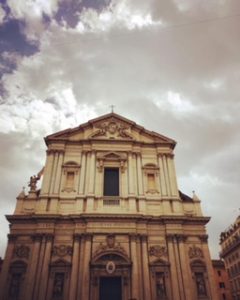
Once you reach Piazza Navona, you can’t miss Bernini’s Fontana dei Quattro Fiumi (Fountain of the Four Rivers) in the middle of the rectangular square. This is where Langdon and Vetra found the fourth cardinal, wrapped in chains and thrown into the fountain to drown. Luckily, he was still alive in the film, but already dead in the book. Behind the fountain, there’s the Chiesa di Sant’Agnese in Agone, designed by Francesco Borromini, a leading figure in the emergence of Roman Baroque architecture and Bernini’s rival.
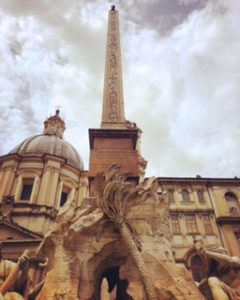
At the northern end of the square, there’s another fountain, the Fontana del Nettuno. At the southern end of the square, there’s the Fontana del Moro, the Chiesa di Nostra Signora del Sacro Cuore and the Museo di Roma. The latter is housed in the Palazzo Braschi and so does Vivi, a cafe overlooking Piazza Navona. Like most Rome museums, the Museo di Roma is closed on Mondays. The museum collection features paintings and photographs.
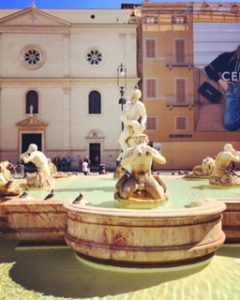
For a panoramic view of Rome’s historical centre, go to Bio Hotel Raphael. The rooftop terrace is a perfect place for an aperitivo. Alternatively, you can stay at Piazza Navona and have tartufo, a ball-shaped gelato-based dessert, at Tre Scalini.
Churches of Rome: From Piazza Navona to Piazza San Pietro
From Piazza Navona, continue to Via dei Coronari, head to Castel Sant’Angelo and the Vatican. Alternatively, you can visit the Vatican on a different day, and head to Piazza Venezia instead (see below).
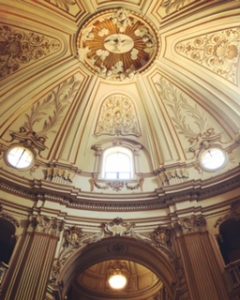
If you choose the first option, continue straight ahead (till the end of Via dei Coronari), then turn right on Via del Banco di Santo Spirito. On your left, there’s the Chiesa dei Santi Celso e Giuliano. Cross the Ponte Sant’Angelo. In front of you, there’s the Castel Sant’Angelo, where Vetra was being held captive. Once she freed herself, she joined Langdon and they ran down the Passetto del Borgo, a secret passageway to the Vatican. Unfortunately, you cannot do the same. Instead, walk on Via della Conciliazione.
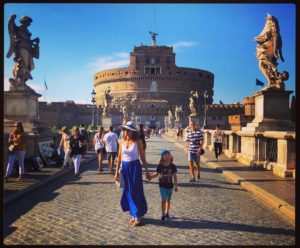
In front of you, there’s the Basilica di San Pietro, Italy’s largest Basilica. It is free to enter, but there is a security check and you may therefore have to queue in Piazza San Pietro. It closes at 7 pm, and the last entry is at 6 pm. In the middle of the round square, there’s a 25m obelisk, brought by Caligula from Egypt. Between the basilica and the obelisk, there’s a stone relief embedded in St Peter’s Square showing West Ponente, the west wind. This is where Langdon and Vetra found the second assassinated cardinal.
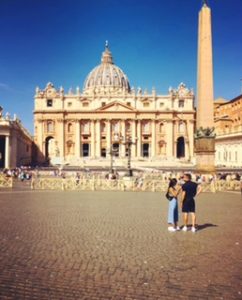
Once you enter the Basilica di San Pietro, go to the right aisle to see Michelangelo’s Pieta. Afterwards, continue towards the centre of the basilica. Bernini’s 29m-high baldachin stands over the papal altar. Look up at Michelangelo’s dome soaring to a height of 119m. Behind the altar, there’s a bronze throne, Bernini’s Cattedra di San Pietro.
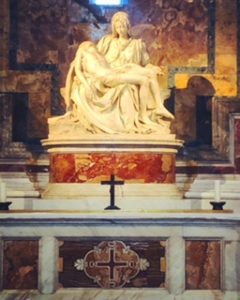
The Vatican Museums
Home to Michelangelo’s Giudizio Universale (Last Judgement), as well as his nine ceiling frescoes, the Cappella Sistina is undoubtedly the jewel in the Vatican crown. To visit the Cappella Sistina, you need to book a ticket (21 euros pp, at least a couple of weeks in advance). The ticket is not just for the Cappella Sistina, but for all the Vatican Museums (Musei Vaticani). Entry is free on the last Sunday of the month. To get to the Cappella Sistina, you have to walk through the Galleria dei Candalabri. From there, continue to Galleria degli Arazzi and the 120m-long Galleria delle Carte Geografiche.
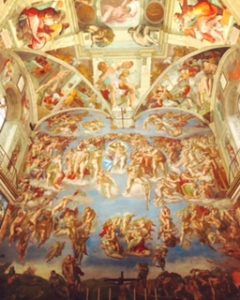
If you have time, visit also the Museo Gregoriano Egizio and the Museo Pio-Clementino, before walking up the stairs to the Galleria dei Candalabri. After the Galleria delle Carte Geografiche, you can visit the Stanze di Raffaello, four frescoed chambers. Raphael only painted the Stanza d’Eliodoro (the second one) and the Stanza delle Segnatura (the third one). The Sala di Constantino and the Stanza dell’Incendio di Borgo were decorated by his students. From the Stanze di Raffaello, continue to the Appartamento Borgia, housing the Vatican’s collection of modern art (including works by Picasso, Van Gogh, Dali and Matisse.
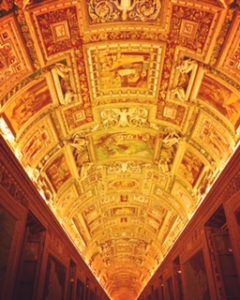
For dinner, I would recommend the Del Frate, a 100-year-old enoteca on Via degli Scipioni.
Churches of Rome: From Piazza Navona to Piazza Venezia
If you decide to visit the Vatican on a different day, head to Piazza Venezia instead. From Via dei Coronari, turn left to Via Arco della Pace, and visit the Chiostro del Bramante and the adjoining Chiesa di Santa Maria della Pace. The former is an art museum and has a bellissima caffeteria that was sadly closed at the time of my visit. Continue on Via di Parione. On your right, there’s the Chiesa di San Tommaso. Continue on Via Sora, then turn left on Corso Vittorio Emmanuele II. On your right, there’s the Basilica di San’Andrea della Valle. A few minutes later, you will see the Chiesa del Gesu. At that point, Corso Vittorio Emmanuele II becomes Via del Plebiscito. Piazza Venezia is only a few minutes away.
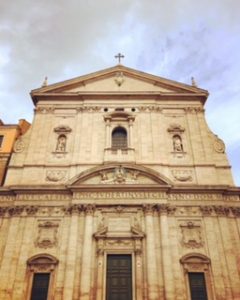
Past Piazza Venezia, continue on Via Quattro Novembre (the continuation of Via del Plebiscito, after the intersection with Via del Corso). On your left, there’s the Piazza and the Basilica dei Sant’ Apostoli. Back on Via Quattro Novembre, there’s the Chiesa Evangelica Valdese on your right (there are opera concerts here). Continue on Via Quattro Novembre, then walk down the steps (on your right) to the Colonna Traiana. On your right, the Chiesa del Santissimo Nome di Maria al Foro Traiano and the Chiesa di Santa Maria di Loreto. On your left, the Via dei Fiori Imperiali leads to the Colosseum. In front of you, the Vittoriano, the iconic building overlooking Piazza Venezia, was built to honour Vittorio Emmanuele II, Italy’s first king.
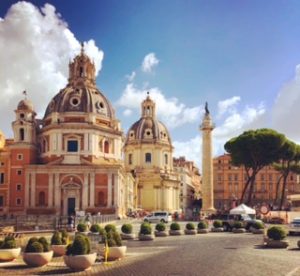
Churches of Rome: From Campo de Fiori to Trastevere
Campo de Fiori and the Jewish Ghetto are both south of Corso Vittorio Emmanuele II and within walking distance from Pizza Venezia, as well as from the Pantheon and Piazza Navona (which are north of Corso Vittorio Emmanuele II). Campo de Fiori is west of Via Arenula, whereas the Jewish Ghetto is south of it. The continuation of Via Arenula to the north leads straight to the Pantheon, whereas its continuation to the south leads to Trastevere.
Start from the busy Campo de Fiori, then cross Piazza Farnese and head to Via Giulia, a quiet cobbled street running almost parallel to the Tiber. The Palazzo Farnese currently houses the French Embassy and is one of the architectural landmarks on Via Giulia. On the southern end of Via Giulia, turn left to Via dei Pettinari. The Chiesa di San Salvatore is on your left and very easy to miss. Further down Via dei Pettinari, there’s the Sicilian pasticceria I Dolci di Nonna Vicenza.
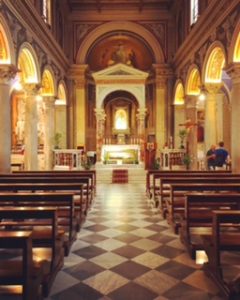
On the other side of the Tiber, there’s Trastevere. As you cross the Ponte Sisto or the Ponte Garibaldi (the continuation of Via Arenula), there’s the Isola Tibertina on your left.
Churches of Rome: From Trastevere to Piazza delle Cinque Scole
Once on the opposite (west) side of the river, head to the Piazza and the Basilica di Santa Maria in Trastevere. The latter is one of the oldest churches dedicated to the Virgin Mary. It incorporates 24 ancient Roman columns. Afterwards, head to the nearby Piazza di San Calisto. Opposite the Chiesa di San Calisto, there’s the Bar San Calisto. Next, wander around Trastevere before you make your way to the Piazza and the Basilica di Santa Cecilia in Trastevere.
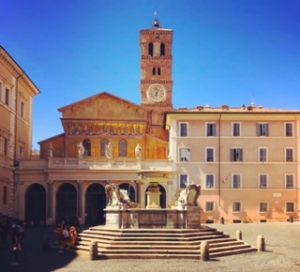
Afterwards, continue to the Jewish Ghetto, on the other side of the river and the other side of Via Arenula in relation to Campo de Fiori. I had dinner at Sora Margherita, a kosher trattoria next to the Chiesa di Santa Maria del Pianto, in the Piazza delle Cinque Scole.
Churches of Rome: From Piazza San Giovanni to Piazza di San Clemente
Monti is a Rome district (rione). Close to the historical centre, it has many churches worth visiting.
Start from the Basilica di San Giovanni in Laterano, the oldest of the four major papal basilicas. Commissioned by the emperor Constantine in the 4th century, this massive church was the first Christian basilica built in Rome and was the Pope’s main place of worship up until the 14th century. In the 17th century, the basilica was revamped by Borromini. Nowadays, it is Rome’s official cathedral and the Pope’s seat as the Bishop of Rome. The baldachin is said to contain the relics of the heads of St Peter and St Paul.
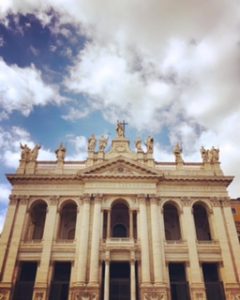
Opposite the Basilica di San Giovanni in Laterano, there’s the Scala Sancta (Pontificio Santuario della Scala Santa), where pilgrims climb up the 28 steps on their knees. The Holy Stairs lead to the Chiesa di San Lorenzo in Palatio ad Sancta Sanctorum. It is also possible to walk up another staircase to reach the church.
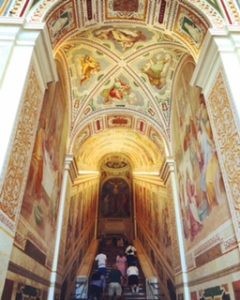
Continue on Via Merulana (past the Chiesa di Sant’Antonio da Padova on your right and the Chiesa dei Santi Marcellino e Pietro al Laterano on your left) and turn left on Via Labicana, or follow Via di San Giovanni in Laterano instead. The Piazza and the Basilica di San Clemente should be your next stop. Although the basilica was built in the 12th century, there had previously been here a church dating from the 4th century. Before that, there had been a 2nd-century temple to Mithras, and even earlier a 1st-century house. The basilica is free to enter, but to see the excavations, you need to book a ticket online (10 euros).
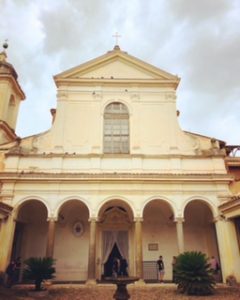
Churches of Rome: From Piazza di San Clemente to Piazza di Santa Maria Maggiore
Walk back towards Via Merulana and then continue towards the Piazza and the Basilica di Santa Maria Maggiore. On your left, there’s the Chiesa di Sant’Anna al Laterano.
Have coffee and maritozzi (cream-filled buns that Romans have for breakfast) at Pasticceria Regoli on Via dello Statuto.
Continue on Via Giovanni Lanza (the continuation of Via dello Statuto, until the intersection with Via Cavour). Past the Chiesa dei Santi Gioacchino e Anna ai Monti, walk up the stairs and visit the 5th-century Basilica di San Pietro in Vincoli (St Peter in Chains). Here you will see the chains that are said to have bound St Peter when he was imprisoned in the Mamertine Prison (Carcere Mamertino). To the right of the main altar, there’s Michelangelo’s Moses.
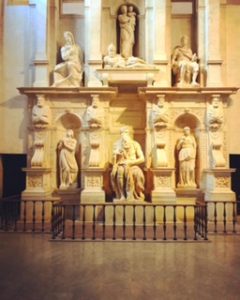
Walk down the stairs and walk back on Via Giovanni Lanza. Turn left on Via San Martino ai Monti. The next stop is the Basilica di Santa Prassede (on the street of the same name). This 9th-century church is home to Byzantine mosaics.
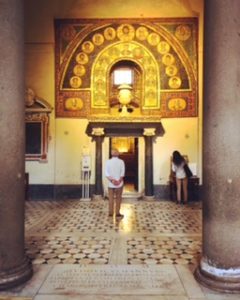
Continue to the Piazza and the Basilica di Santa Maria Maggiore, on the summit of the Esquiline Hill. Dating to the 5th century, this is one of the first churches built in honour of the Virgin Mary. Together with the Basilica di San Giovanni in Laterano, the Basilica di San Pietro and the Basilica di San Paolo fuori le Mura (St Paul Outside the Walls), it is one of the four major papal basilicas.
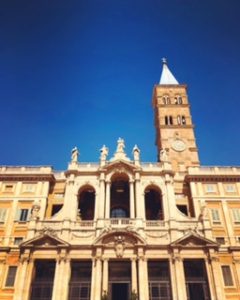
Churches of Rome: From Piazza di Santa Maria Maggiore to Via Nazionale
Afterwards, continue on Via Torino. At the intersection with Via Nazionale, turn right, cross the Piazza della Repubblica and visit the 16th-century Basilica di Santa Maria degli Angeli e dei Martiri, built inside the ruined frigidarium of the Terme di Diocleziano (the Baths of Diocletian). The basilica’s design was by Michelangelo.
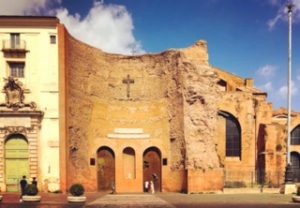
Continue on Via Nazionale towards Piazza Venezia. On your left-hand side, there’s the Chiesa di San Paolo entro le Mura (St Paul Within the Walls). Dating to the 19th century, this is the first non-Catholic church in Rome. There are opera concerts twice a week, on Thursday and Saturday evenings.
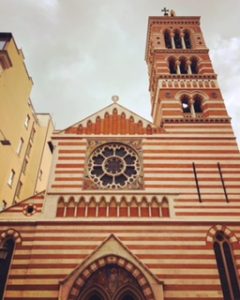
Further down on Via Nazionale, on your right-hand side, there’s the 5th-century Basilica di San Vitale (e Compagni Martiri in Fovea). Right next to the basilica, there’s the Palazzo delle Esposizioni, an exhibition centre with a beautiful cafe.
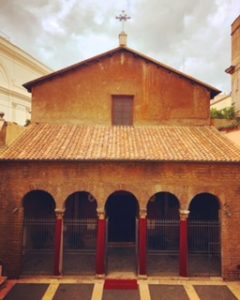
Churches of Rome: From Via Nazionale to Piazza San Bernardo
Continue back on Via Nazionale, towards the Piazza della Repubblica, but turn left on Via delle Quatro Fontane. At the intersection with Via del Quirinale and its continuation Via XX Settembre, there’s the Chiesa di San Carlo alle Quattro Fontane, commonly called San Carlino. It is easy to miss, but well worth a visit. The church was designed by Borromini. There’s a crypt, free to visit.
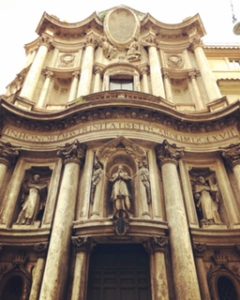
Continue on Via XX Settembre. On your right-hand side, there’s the Chiesa Evangelica Metodista di Roma (there are opera concerts here as well).
You will soon arrive at the Piazza San Bernardo. On your right, the Chiesa di San Bernando ‘alle Terme’. On your left, are the twin churches of Santa Susanna alle Terme di Diocleziano and Santa Maria della Vittoria. The latter is where Langdon and Vietra found the third assassinated cardinal, burning suspended from the ceiling on cables meant for lanterns. The highlight of the church is Bernini’s Santa Teresa trafitta dall’ amore di Dio.
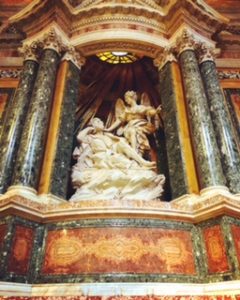
If it’s time for lunch, I would recommend Pan Bernardo (at the Piazza San Bernardo) or Pasticceria Dagnino (in an arcade that you can enter from Via Torino, just a minute away from the Piazza San Bernardo).
La Grande Bellezza, one of my favourite restaurants in Rome, is about 5-minutes away from the Chiesa di Santa Maria della Vittoria (on Via Flavia).
Further reading
To better prepare for my trip in Rome, I used the Lonely Planet Italy Travel Guide.
If you’ve worked out an appetite for Italy, check out my 10-day trip to Southern Italy. After landing in Bari, the capital and the largest city of Puglia, I visited the inland towns of Alberobello and Locorotondo, as well as the seaside Monopoli and Polignano a Mare. I then visited Matera, a city located not in Puglia, but in the neighbouring region of Basilicata. After staying there for a couple of days, I took the bus to Lecce and returned to Puglia. From there, I continued to Ostuni, Cisternino and Brindisi.
Alex
(the Traveling Psychiatrist)
One Comment
Pingback: